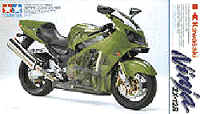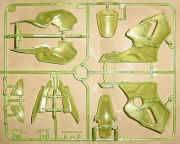|
At the Paris Motorcycle Show in 1999, Kawasaki introduced its new Ninja ZX-12R.
According to Tamiya, this new release by Kawasaki is the answer to the requirements of many users who want to reach 300 Km/h!!
This Ninja was produced using much of the aeronautics technology, especially aerodynamics.
The kit we are going to analyze in this article is the latest Tamiya # 84 release.
|

|
The kit
When we think that we have seen it all, and nothing new would appear in years to come, Tamiya always gives us a surprise. Their last 1/12 motorcycles releases were all competition models, but with this new kit Tamiya returns to the street motorcycles … but what a motorcycle, what a presentation!
|
The first thing that attracts our attention is the box. The artwork is not very elaborated; just a photograph of the real thing with some transparency special effects that let us see part of the contents of the box.
|
This detail is closely related to the kit presentation. The body is made of TRANSPARENT fluorescent green plastic. This kit reminds us of those kits of the 80's.
If you wish, you can leave the body unpainted, but it will be almost impossible to remove the joint marks on the fuel tank. The best way to solve this problem is to paint the body and leave just the fairing transparent. The engine fairing is divided in three sections; this enables you to remove the lateral panels and see the engine work.
|

|
In case you decide to paint the body, Tamiya suggests four colors: green, silver, blue and red. Please note that the painting of the lower part of the fairing is different from the rest. This should be taken into account when we choose the paint scheme. The instruction manual refers to TS-B and TS-C as colors for the body and then indicates which they are, according to the selected color scheme.
Tamiya suggests the use of its new metallic enamels X31, X32, X33, X34. They are really high quality paints, especially if applied with an airbrush. It would be advisable not to thin them down very much in order to achieve a more homogeneous finish.
The engine area is well detailed, but I think it is necessary to get some good photographic references to be able to add some wires, in addition to what the instruction manual indicates.
The construction is typical of a Tamiya model; the engine is fixed into place with screws.
After a quick inspection, three features attracted my attention: the good detailing of the headlights, the brake system and the turn lights, which are of red and orange transparent plastic. This is the first time Tamiya offers colored plastic for these particular parts in motorcycles of this scale. We really appreciate it very much because, with this feature, this kit surpassed all others.
The exhaust pipe and the muffler are chromed parts. If case you need to repair chipped chrome, you can paint the scratch with an X11 marker and, when dry, apply just a drop of glossy acrylic varnish. The use of aluminum foil is also recommended.
Conclusion
This kit supplies a small transparent plastic support but I would personally use the lateral support the bike provides, although it looks quite fragile.
What else can I say? Another piece for the always demanding taste of motorcycle fans. If this is your first Tamiya kit, you will be amazed and I am sure that your collection will grow very fast.
For an expert modeler, this kit offers no new challenges, just the pleasure of working with a Tamiya kit. Its price is similar to those of previous models and I think that this new Kawasaki is worth a place in our collection.
|